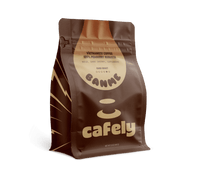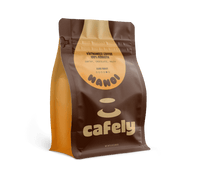How do you make the best coffee with an AeroPress?
Great coffee starts with great beans so you can get consistent, flavorful coffee.
This guide walks you through the best beans to order when using an AeroPress so you can enjoy barista-grade coffee at home.
Best Coffee for AeroPress: Top Recommendations
The AeroPress has a magical way of making clean, smooth, rich coffee in less than one minute with a straightforward brewing process.
It uses a blend of immersion and pressure to extract essential flavors and oils from coffee beans.
Coffee only tastes as good as the beans it’s brewed from. These four recommendations are the ideal fit for your AeroPress:
1. HaNoi Coffee Beans

Dark roast with mild acidity, Cafely HaNoi suits espresso, moka pot, phin, or AeroPress coffee. It’s a 100% robusta blend delivering full-body, intense coffee, especially when brewed in an AeroPress.
Individual flavors are identifiable in a clean brew.
The filter in an AeroPress prevents unwanted debris from entering the final cup, so all that’s left behind are the dark, earthy, malty notes from Cafely HaNoi.
2. DaNang Coffee Beans

Cafely DaNang takes you on a journey with every sip.
At first, the nutty warmth of hazelnut takes center stage before sweet maple syrup and citrus notes linger on the tongue.
The equal blend of robusta and arabica beans produces balance, with bold but smooth flavor and a distinctive vibrant edge.
3. DaLat Coffee Beans

This 100% Vietnamese arabica promises every cup will ignite your senses with caramel, fruity tones, and a kick of caffeine.
More flavorful than regular arabica, Cafely’s DaLat encompasses floral, bright undertones to make a fresh, refined coffee.
The full flavor is matched with a smoothness that makes a cup enjoyable at any time of the day.
4. SaiGon OG Coffee Beans

Cafely SaiGon OG is a bestseller and for good reason.
The blend of robusta, arabica, and peaberry produces an unparalleled brew with a taste as unique and diverse as Saigon City.
Peaberry beans bring a refreshing twist, robusta ensures strength, and arabica smoothes and unites flavors.
The buttery finish makes SaiGon OG a delicious alternative to your regular morning brew.
5. BanMe

Bold, strong, and full of flavor, Cafely BanMe promises a coffee that’s deeply infused and matched with intense strength.
This 100% peaberry robusta blend highlights notes of cherry and chocolate, boosted by a slight bitterness from the high caffeine content.
Deeply aromatic, this peaberry blend expresses coffee’s strength and ability to produce dynamic flavors.
How to Choose the Best Beans for an AeroPress
There are quite a few things that affect the quality of coffee beans — you’ll enjoy your cup of coffee more if you take the time to dial in the details.
1. Make Sure It’s the Right Grind

Purchasing whole beans adds extra responsibility to your coffee routine, but it provides the best freshness and flavor. It also gives you control over the size of the grind — an often overlooked aspect of brewing coffee.
Most pre-ground coffee is a medium-grind, which is okay for most methods. However, you’ll get better depth and flavor if you learn how to properly grind coffee and use the correct grind for the brewing method. You want better than “okay” coffee.
An AeroPress works best with a medium-fine grind, which when paired with a short brewing time, makes for even extraction and a flavorful brew. Achieve the perfect grind size by using a quality grinder such as a conical burr — a grinder that’s able to produce smooth, even grounds and preserve original flavor.
2. Use a Roast You Enjoy

Various roasts of coffee are available and each one produces different flavors. Medium roasts are a familiar favorite, producing a balanced flavor and inviting aroma.
However, any roast works well with AeroPress brewing, and your choice depends on personal preference. Stick to a medium-fine grind and your brew will be delicious regardless of the roast.
Light roast coffee is sweet and fruity and darker roasts offer deeper, warmer tones of chocolate and a slightly bitter edge. Medium roasts have complex, lighter notes and less bitterness and acidity.
3. Robusta or Arabica Coffee?
There are over 100 species of coffee plants [1], but we’re focusing on arabica and robusta.
Both types of beans produce mouthwateringly good coffee, but with some key differences shown in the table below:

In terms of which coffee beans to use in an AeroPress, either type will do. Robusta is usually preferable for stronger brews and arabica is preferred for smoother brews.
4. Determine the Country of Origin
Coffee is grown globally in varying climates, conditions, and soil, influencing coffee bean flavor.
The countries producing the most coffee beans include:

- Brazil
- Vietnam
- Columbia
- Indonesia
- Ethiopia
Coffee from various regions of the world has a distinctive flavor and flair thanks to the difference in environmental conditions.
Coffee thrives in cool to warm tropical climates with rich soil. So, it’s no surprise the world’s Coffee Belt spreads from North, Central, and South America to the Caribbean, Africa, the Middle East, and Asia. Even small variations in temperature, rainfall, altitude, or soil quality can affect coffee beans by damaging plants, stunting growth, yellowing leaves, and exacerbating pests.
The growing environment has a lasting impression on the plant, and, in turn, the fruit and subsequent beans it produces.
Related: History of Coffee
Pro Tips: Using the Best Beans for the Perfect Cup of AeroPress Coffee
Making the best coffee with an AeroPress is a matter of learning a few key steps. You won’t look back once you’ve tasted an AeroPress coffee brewed the right way with quality beans.
Check out our guide on brewing coffee with an AeroPress for more detailed instructions.
Step 1: Grind the Beans

For an AeroPress, grind your beans to a medium-fine grind, similar to a sandy texture. You can use pre-ground, but whole beans are fresh and produce a far richer flavor.
Grind the amount of coffee you need depending on your AeroPress model and the style of coffee you’re brewing.
Step 2: Prepare the AeroPress

Take out the plunger on your device, followed by the filter cap.
Once removed, place a filter inside and screw the cap to the bottom of the Aeropress chamber.
Grab your favorite mug and place it underneath the chamber with the filter at the bottom.
Step 3: Add the Coffee

Add the amount of coffee you desire to the chamber and fill the AeroPress with water to the fourth line (use one scoop for a standard American brew or two for coffee similar to a double-shot espresso).
If making espresso-style coffee, fill the water to the second line.
Step 4: Stir the Coffee

Stir the coffee for around 10 seconds before allowing the grounds to settle for 30 seconds.
Step 5: Use the Plunger

Attach the plunger to the AeroPress and gently push it down to strain the coffee through the filter. This takes about 30 seconds, but don’t apply too much force — consistent pressure is the goal.
Vietnamese-inspired coffee is a little different, so if this is the type you’re brewing, leave the plunger to one side and let the coffee slowly drip through the filter for a few minutes. Only use the plunger if it’s been over 7 minutes and you’re still waiting for your brew.
Mistakes to Avoid for the Best AeroPress Coffee
An AeroPress provides a simple but effective brewing technique for coffee enthusiasts to enjoy a cup wherever they are. Compact in size but big on function, it’s important to use an AeroPress right.
To guarantee the tastiest cup of coffee, avoid the following common mistakes:
- Using the wrong grind
- Brewing with a dirty AeroPress
- Opting for poor-quality beans
- Pressing the plunger too quickly
Pairing the Best AeroPress Coffee With Food
Coffee can make simple foods taste epic. Quality, flavorful beans make this easier, and the AeroPress brewing process promises you won’t be waiting long for a caffeine hit.
Once your brew is complete, pair it with delicious food, elevating flavors and shaping your coffee experience.
Below, we list a few great options that pair wonderfully with a cup of coffee.

Matching food with coffee brings depth and complex flavors to life, so you can taste coffee in a whole new way. It boils down to taking foods you like and combining them with the coffee beans you’re using.
Light, fruity beans pair well with dishes containing fruit such as tarts or fruity pastries.
Darker roasts with humbling earthy tones partner well with chocolate, elevating overall warmth and nuttiness.
Maintaining the AeroPress for Consistently Good Coffee

AeroPress devices are easy to clean. They should be cleaned carefully after each use. Stay on top of your AeroPress maintenance to keep it in the best condition possible. Clean equipment results in a cleaner brew.
Follow these steps when cleaning your AeroPress:
- Step 1: Remove the coffee puck to access the plunger and chamber. Rinse each section with warm water, cleaning out any crevices where grounds can become trapped.
- Step 2: There’s no need to use chemical cleaners on your AeroPress. Remove any stubborn stains with hot water and baking soda, rinsing the device thoroughly afterward to remove any residue.
- Step 3: Deep clean your AeroPress once a month with hot water and baking soda to keep it in tip-top condition. Rinse it out after every use and you’ll be left with an AeroPress that’s always ready to brew.
- Step 4: Store your AeroPress with the silicone seal pushed all the way through the chamber for optimal results. This promises the plunger will remain effective for many cups of coffee, and the device is clean and ready to be used again.
FAQs: The Best Coffee for AeroPress

Mulling things over about the best coffee for AeroPress?
Let’s see if any of these FAQs answers your thoughts.
1. What is the Best Grind Size for AeroPress?
Medium-fine grind is the ideal size for an Aeropress, with a texture like table salt.
2. Can I Use Robusta Beans in an AeroPress?
Robusta beans can be used in an AeroPress and they make a deliciously strong, rich-bodied brew.
3. How Can I Avoid a Bitter AeroPress Coffee?
Using quality fresh coffee beans, grinding them to the correct size, and avoiding over-extraction are key ways of ensuring a smooth brew with less bitterness.
4. What Makes a Good Coffee Blend for AeroPress?
A perfect coffee blend for AeroPress needs a balance of strength, flavor, and body, often including robusta and arabica beans.
5. How Often Should I Clean My AeroPress?
An AeroPress should be cleaned after every use to keep it in better condition, brewing better cups of coffee. Give your AeroPress a deeper clean once a month.
Related: How to Clean My Coffee Maker
6. What is the Ideal Water Temperature for AeroPress?
Between 175°F and 195°F (80°C to 90°C) is the perfect water temperature for brewing with an AeroPress, ensuring even extraction and a balanced brew.
7. Can I Use Pre-Ground Coffee for AeroPress?
Pre-ground coffee can be used in an AeroPress, but freshly ground beans provide better overall flavor.
8. How Can I Improve the Flavor of My AeroPress Coffee?
The flavor of AeroPress coffee improves with quality, fresh beans, the proper grind size, and well-maintained equipment that’s clean and free of old coffee grounds.
9. What Are the Benefits of Using an AeroPress?
AeroPress benefits include easy use,versatile set-up, and dependable results producing rich coffee every time.
10. Can I Use Any Type of Coffee in an AeroPress?
Use any coffee in your AeroPress, but be aware that medium to dark roasts are preferable for full, deep, rich flavors, unmatched by lighter roasts.
References
- Lachenmeier, D. W. (2023). Identification of Coffee Species, Varieties, Origins, and Processing and Preparation Methods—A Status Report. Proceedings, 89(1), 9. Retrieved on July 5 2024 from












